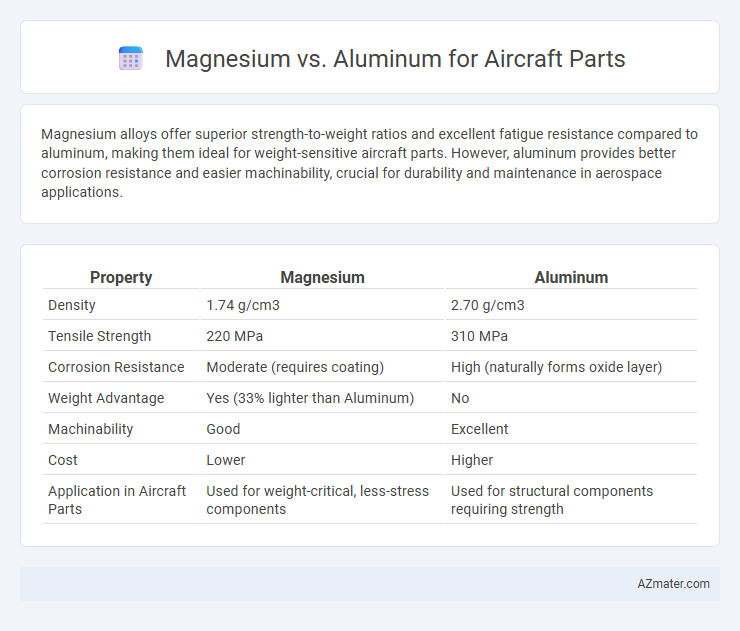Magnesium alloys offer superior strength-to-weight ratios and excellent fatigue resistance compared to aluminum, making them ideal for weight-sensitive aircraft parts. However, aluminum provides better corrosion resistance and easier machinability, crucial for durability and maintenance in aerospace applications.
Table of Comparison
| Property | Magnesium | Aluminum |
|---|---|---|
| Density | 1.74 g/cm3 | 2.70 g/cm3 |
| Tensile Strength | 220 MPa | 310 MPa |
| Corrosion Resistance | Moderate (requires coating) | High (naturally forms oxide layer) |
| Weight Advantage | Yes (33% lighter than Aluminum) | No |
| Machinability | Good | Excellent |
| Cost | Lower | Higher |
| Application in Aircraft Parts | Used for weight-critical, less-stress components | Used for structural components requiring strength |
Introduction to Magnesium and Aluminum in Aircraft Manufacturing
Magnesium and aluminum are key metals in aircraft manufacturing, valued for their lightweight properties that enhance fuel efficiency and performance. Magnesium offers exceptional strength-to-weight ratio and excellent vibration damping, making it ideal for components requiring high structural integrity with reduced weight. Aluminum is widely used for its corrosion resistance, ease of fabrication, and cost-effectiveness, often serving as the primary material in airframe and skin construction.
Material Properties: Magnesium vs Aluminum
Magnesium offers a lower density of approximately 1.74 g/cm3 compared to aluminum's 2.70 g/cm3, enabling significant weight reduction in aircraft parts. Aluminum exhibits superior corrosion resistance and higher tensile strength, typically ranging from 200 to 550 MPa, whereas magnesium alloys offer tensile strengths around 200 to 350 MPa. Thermal conductivity in magnesium (around 156 W/m*K) is higher than aluminum's (approximately 130 W/m*K), influencing heat dissipation in critical aircraft components.
Weight Comparison and Its Impact on Aircraft Performance
Magnesium alloys are significantly lighter than aluminum alloys, with a density of approximately 1.74 g/cm3 compared to aluminum's 2.70 g/cm3, resulting in up to 35% weight savings in aircraft components. This reduction in weight improves fuel efficiency, increases payload capacity, and enhances overall aircraft agility and range. However, magnesium's lower corrosion resistance and reduced strength relative to aluminum require protective coatings and design considerations to ensure durability and safety in aerospace applications.
Strength and Durability: Which Metal Prevails?
Magnesium offers a high strength-to-weight ratio, making it ideal for lightweight aircraft components, but aluminum surpasses magnesium in overall durability and resistance to corrosion, especially in harsh environmental conditions. Aluminum alloys, such as 7075 and 2024, provide superior tensile strength and fatigue resistance, ensuring longer service life under cyclic loading. While magnesium is lighter, aluminum remains the preferred choice for critical aircraft parts demanding optimal strength and longevity.
Corrosion Resistance in Aviation Environments
Magnesium alloys, while lightweight, exhibit lower corrosion resistance compared to aluminum alloys in aviation environments due to their higher susceptibility to oxidation and galvanic corrosion. Aluminum alloys, especially those treated with protective coatings like anodizing or Alclad layers, provide superior corrosion resistance, enhancing durability in humid and salt-laden conditions typical of aircraft operation. The choice between magnesium and aluminum for aircraft parts depends significantly on balancing weight reduction with long-term corrosion performance and maintenance requirements.
Cost Analysis: Magnesium vs Aluminum
Magnesium offers a lower material cost compared to aluminum, making it an attractive option for reducing aircraft part expenses; however, processing and corrosion prevention treatments can increase overall costs. Aluminum provides better durability and corrosion resistance, often resulting in lower maintenance and replacement expenses over the aircraft's lifecycle. Total cost analysis must incorporate factors such as raw material prices, fabrication complexity, part longevity, and maintenance requirements to determine the most cost-effective choice for specific aircraft components.
Machinability and Fabrication Processes
Magnesium offers superior machinability compared to aluminum due to its lower density and softer nature, resulting in faster cutting speeds and reduced tool wear during aircraft part fabrication. Aluminum, while harder than magnesium, provides greater strength and corrosion resistance, making it suitable for structural components requiring durability. Fabrication processes for magnesium demand stringent fire prevention measures because of its flammability, whereas aluminum machining is more straightforward with established protocols in aerospace manufacturing.
Safety Considerations for Aircraft Applications
Magnesium's lightweight properties provide significant weight reduction benefits in aircraft parts but require careful consideration due to its higher flammability and susceptibility to corrosion compared to aluminum. Aluminum offers superior corrosion resistance and a well-established safety record in aviation, making it a preferred choice for structural components where fire risk and durability are critical. Safety considerations emphasize aluminum's ability to withstand extreme environmental conditions without compromising structural integrity, while magnesium demands protective coatings and rigorous maintenance to mitigate safety risks.
Environmental Impact and Sustainability
Magnesium offers a lower environmental footprint due to its abundance and higher recyclability compared to aluminum, which requires more energy-intensive extraction and processing. The production of aluminum releases significantly more greenhouse gases, contributing to a larger carbon footprint in aircraft manufacturing. Utilizing magnesium alloys in aircraft parts supports sustainability efforts by reducing weight and improving fuel efficiency, thereby lowering overall emissions during the aircraft's operational life.
Future Trends in Aircraft Materials: Magnesium or Aluminum?
Magnesium's lightweight properties and high strength-to-weight ratio make it a promising candidate for future aircraft components, potentially reducing overall fuel consumption and emissions. However, aluminum remains favored for its superior corrosion resistance and established manufacturing processes in aerospace applications. Emerging trends focus on advanced magnesium alloys and hybrid materials that aim to combine magnesium's weight advantages with aluminum's durability for next-generation aircraft design.

Infographic: Magnesium vs Aluminum for Aircraft Part
 azmater.com
azmater.com